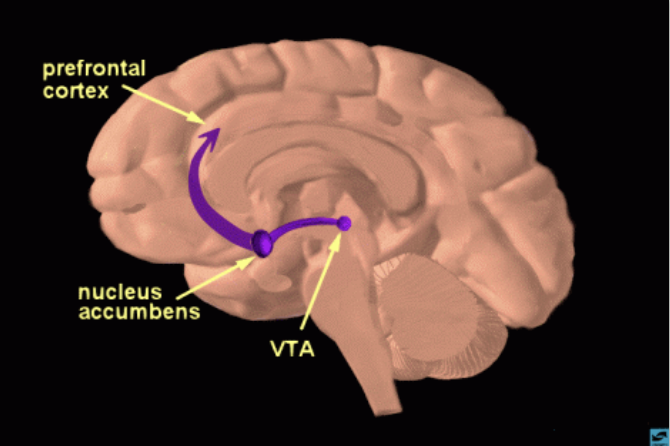Biological explanations of addiction
 The origins of addiction are quite complex and not fully understood by psychologists. Addiction occurs when people become physically dependent on a substance through repeated use. This chapter will include research on a range of substances - including nicotine, alcohol, and "harder drugs" such as cocaine and heroin.
The origins of addiction are quite complex and not fully understood by psychologists. Addiction occurs when people become physically dependent on a substance through repeated use. This chapter will include research on a range of substances - including nicotine, alcohol, and "harder drugs" such as cocaine and heroin.
There are two basic approaches to the origins of addiction. The disease model of addiction argues that addiction has biological roots and is a problem with which the individual will struggle throughout his/her life. The addiction is believed to have a genetic origin.
The role of dopamine
In the study of addiction, one neurotransmitter seems to stand out - dopamine. However, research on addiction shows that it is a "chemical cocktail" of several neurotransmitters that may be important, with each chemical playing a different role. Researchers have looked at the role that the brain's reward pathway plays in addiction.
The brain's reward pathway
 Nicotine binds to receptors in a region of the brain called the ventral tegmental area (VTA). These neurons trigger the release of dopamine in the nucleus accumbens (NAc).
Nicotine binds to receptors in a region of the brain called the ventral tegmental area (VTA). These neurons trigger the release of dopamine in the nucleus accumbens (NAc).
In addition, the release of Glutamate, an inhibitory neurotransmitter, appears to play a role in the creation of a "memory loop" - which links the substance to the feelings of pleasure.
Cigarette smoke also contains a substance that blocks the action of an enzyme called MAO. MAO is normally responsible for breaking down dopamine after it has had its effects. Therefore, blocking MAO results in even higher dopamine levels, strengthening the smoking habit by maintaining feelings of pleasure.
The following video is a good explanation of the chemistry of addiction
A drug may act as an agonist for a neurotransmitter - that is, the drug may bind to a receptor site on a post-synaptic neuron, causing the neuron to fire. Alcohol, for example, binds with dopamine receptor sites, causing dopamine neurons to fire. The firing of these neurons results in the activation of the brain's reward system - the nucleus accumbens.
Setiawan et al (2013) carried out a study with 26 healthy social drinkers. The researchers categorized the drinkers based on their risk for alcoholism based on personality traits and having a lower intoxication response to alcohol - that is, they did not feel as drunk despite having drunk the same amount as other drinkers. Each participant underwent a PET scan after drinking either juice and then later, alcohol. In each condition, they were asked to drink three drinks in 15 minutes.
It was found that when drinking alcohol, those who were considered "high risk" for alcoholism showed significantly greater activity in the nucleus accumbens. The researchers argued that alcohol is an agonist for dopamine, connecting to dopamine receptor sites and causing the neurons to fire. It is hypothesized that people with a potential for alcoholism have a greater response to the agonist than those at low-risk. Research shows that people with a low level of dopamine neuron activity as a result of alcohol consumption often get tired after drinking a small amount of alcohol. This is because the level of dopamine activity is not high enough to counteract the sedative effects of alcohol. By studying the way in which alcohol acts as an agonist on dopamine neurons, it is also possible that researchers could find ways to treat the disorder.
Ethics in addiction research
 There have been several controversial studies carried out in psychology to look at the role of the reward pathways on behaviour.
There have been several controversial studies carried out in psychology to look at the role of the reward pathways on behaviour.
In the 1950s, Robert Heath found that by electrically stimulating the nucleus accumbens, depressed patients would experience pleasure. In one example, during a three-hour session, a participant referred to as B-19 electrically stimulated himself 1500 times. According to Heath's 1972 study published in the Journal of Behaviour Therapy and Experimental Psychiatry, “during these sessions, B-19 stimulated himself to a point that he was experiencing an almost overwhelming euphoria and elation, and had to be disconnected, despite his vigorous protests”.
At around the same time, James Olds carried out research on rats to see what would happen if their pleasure centers were stimulated. He devised an experiment in which the rat would receive electrical stimulation of the nucleus accumbens by pressing a lever. It was found that the rats were willing to walk across electrified grids in order to get to the “pleasure lever”. In fact, they even preferred the stimulation to eating and drinking.
Looking specifically at drug addiction, the classic study by Deneau, Yanagita & Seevers (1969) taught rhesus monkeys to self-inject drugs such as morphine, amphetamines, and cocaine. In the case of cocaine, they found that the monkeys would continue taking the drug until they overdosed.
In all of these studies, the question is to what extent did the findings of the studies outweigh the costs to the humans or animals involved.
Although the research above seems to indicate that the nucleus accumbens plays a key role in addiction, remember that when using animal models, there are limitations. When studying drug abuse in humans, factors such as laws, culture, religion and economics all play a potential role in the behaviour. Today we are able to do a lot of research on humans that used to be done only on animals - primarily thanks to the development of noninvasive brain scanning techniques that allow researchers to observe the brain's response to drugs.
Genetic vulnerability
In order to develop a genetic argument for the origins of addiction, psychologists carry out family and twin studies. If addiction has a genetic component, we should see addictive behaviours running within families - and in cases of twins, identical twins (MZ) should have a higher rate of both of them having addictive behaviour than fraternal twins (DZ).
Kendler & Prescott (1998)
 Kendler & Prescott (1998) examined the patterns of marijuana and cocaine use by female twins and found that genetic factors play a major role in the progression from drug use to dependence. The researchers interviewed 1,934 twins, ranging in age from 22 to 62. In the study, drug "use" involved at least one non-prescribed use of a drug; "dependence" was based on the DSM-IV definition and included characteristics such as physical symptoms of tolerance or withdrawal, taking larger amounts of the drug or using it over a longer period than intended, or spending large amounts of time seeking, obtaining, and recovering from the effects of the drug.
Kendler & Prescott (1998) examined the patterns of marijuana and cocaine use by female twins and found that genetic factors play a major role in the progression from drug use to dependence. The researchers interviewed 1,934 twins, ranging in age from 22 to 62. In the study, drug "use" involved at least one non-prescribed use of a drug; "dependence" was based on the DSM-IV definition and included characteristics such as physical symptoms of tolerance or withdrawal, taking larger amounts of the drug or using it over a longer period than intended, or spending large amounts of time seeking, obtaining, and recovering from the effects of the drug.
Their research indicated that family and social environmental factors are influential in determining whether an individual begins using drugs, but the progression from the use of cocaine or marijuana to abuse or dependence was due largely to genetic factors. The study found that concordance rates - both twins using, abusing, or being dependent on drugs - were higher for identical than fraternal twins. For example, for cocaine dependence concordance was 35 percent in identical twins and zero for fraternal twins.
One of the genes that researchers are focusing on is the DRD2 gene which codes for the number of dopamine receptors available in the brain's reward system. A person with fewer dopamine receptors is unable to 'feel' the effect of dopamine as well as someone with a higher number of dopamine receptors, and so needs higher levels of dopamine to produce the same effect as a person with more dopamine receptors. People with the DRD2 A1 variation of the gene have fewer dopamine receptors, and also seem more vulnerable to addictions.
In a study of 103 alcohol-dependent males, Ponce et al (2008) found that 39% carried the DRD2 A1 allele. He found that those with the allele had a higher prevalence of alcoholism in the family and an early onset of alcohol abuse. However, the research on the DRD2 A1 gene has been inconsistent.
- Much of the research is done on animals. It is questionable to what extent we can generalize the findings from animal models to humans.
- The results of addiction research are inconsistent - that is, there is not a high level of reliability. Different drugs seem to have different levels of concordance in twins. Is this the nature of the drugs or does this have something to do with the way that the genes work?
- There are questions of construct validity when discussing "addiction." When discussing the origins of addiction, are we talking about the initiation of drug use - that is, why the person started using the drug in the first place? Or are the genes responsible for the level of addiction? It is difficult to separate out these issues.
- Although twin studies seem to indicate that there is some genetic component to addiction, it is not yet clear which genes are responsible and what role they may play in addiction.
- A genetic argument is both reductionist and deterministic. Although a genetic factor may have to interact with the environment in order to produce addictive behaviour, the argument still posits that if an individual has the correct set of genes, then he is more likely to be addicted to the substance.
ATL: Reflection
Do you think that it is helpful to know that you might have a gene that could lead to addiction? Why or why not?
If you think that it is helpful, would you recommend that all teens get their DNA tested so that they would better understand the risk of addiction?
Do you think that it is helpful to know that you might have a gene that could lead to addiction? Why or why not?
This first reflection is about their own feelings about the idea of genetic determinism. Many students say that they would want to know so that they could avoid certain behaviours, but others worry about a self-fulfilling prophecy.
In order to extend the discussion, you may want to give your students the following article: Do you really want to know what is lurking in your genome?
If you think that it is helpful, would you recommend that all teens get their DNA tested so that they would better understand the risk of addiction?
This question moves away from personal reflections to the potential application of research findings. There are definitely concerns about individual privacy and societal labeling of individuals. Another article to spark discussion is here: Should we screen kids' brains and genes to ID future criminals?

 IB Docs (2) Team
IB Docs (2) Team
